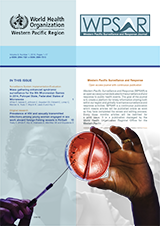Prevalence of HIV and sexually transmitted infections among young women engaged in sex work aboard foreign fishing vessels in Kiribati
DOI:
https://doi.org/10.5365/wpsar.2017.8.4.005Abstract
Objective: To assess the prevalence of HIV and sexually transmitted infections (STIs) among women who board foreign fishing vessels for sex work in Kiribati.
Methods: A cross-sectional study was designed to collect data on behavioural risk factors for STIs and knowledge of and attitudes towards HIV and STIs during 2007. Urine and blood samples were collected to test for HIV and select STIs. Descriptive statistics were performed for sociodemographic and behavioural characteristics, and chi-squared tests were used to assess associations between potential key determinants and the presence of genital Chlamydia infection.
Results: Women who boarded foreign fishing vessels for transactional sex were younger, had less education, were less likely to live with a partner and were less likely to be otherwise employed. Although no HIV infections were detected, more than half (57.5%) of the women were diagnosed with an STI. One quarter of the women tested positive for chlamydia, and 40% tested positive for mycoplasma. The presence of chlamydia was strongly associated with age at first sexual intercourse (P = 0.02) and number of sexual partners during the prior seven days (P = 0.02).
Conclusion: The high rate of STIs in this population of sex workers is concerning given the potential of severe pregnancy-related and chronic health problems and the increased risk of transmission within the general population of Kiribati. We identified a specific sex worker population as a priority group for targeted public health efforts to prevent and control the spread of STIs in Kiribati.
References
Kiribati National Statistics Office. 2005 Census of Population. Volume I: Basic information and tables (revised version) (http://www.mfed.gov.ki/statistics/kiribati-document-library, accessed 15 March 2016).
Kiribati Ministry of Health and Medical Services. Kiribati HIV/AIDS/TB Task Force (KHATBTF), STI and HIV/AIDS Strategic Plan 2005-2008. Tarawa, Kiribati.
Kiribati Ministry of Health and Medical Services. Kiribati Global AIDS Response Progress Report 2012 (http://files.unaids.org/en/dataanalysis/knowyourresponse/countryprogressreports/2012countries/ce_KI_Narrative_Report.pdf, accessed 20 March 2016).
Asian Development Bank. Country strategy and program update. Kiribati (2006-2007). Manila, Asian Development Bank, 2006.
The World Bank. Opportunities to improve social services in Kiribati. Human development in the Pacific Islands. Washington DC, The World Bank, 2007 (http://documents.worldbank.org/curated/en/117551468289223392/Opportunities-to-improve-social-services-in-Kiribati, accessed 22 March 2016).
Kiribati Ministry of Health and Medical Services. Morbidity and Mortality database, Health Information Centre (http://www.health.gov.ki/public-health-services.html#health-information, accessed 22 March 2016).
World Health Organization. Second Generation Surveillance Surveys of HIV, Other STIs and Risk Behaviours in 6 Pacific Island Countries (2004-2005) (http://www.wpro.who.int/hiv/documents/SGS_FINAL_DOCUMENT/en/, accessed 3 March 2016).
United Nations Population Fund. Sexual Knowledge and Attitudes of Adolescents in Kiribati UNFPA Research Papers in Population and Reproductive Health. The State of Pacific Youth – 2005. Health No.5/2002. Suva: UNFPA.
RRRT (Regional Rights Resources Team) and UNICEF, 2004. Situation Analyses of Child Abuse and Commercial Sexual Exploitation of Children in Kiribati, Solomon Islands and Vanuatu. Unpublished reports. Suva: RRRT and UNICEF.
Ramjee G, Karim SS, Sturm AW. Sexually transmitted infections among sex workers in KwaZulu-Natal, South Africa. Sex Transm Dis. 1998;25:346-9.
Esquivel CA, Briones Ezcarzaga ML, Castruita Limones DE, Lazalde Ramos BP, Salas EV, Gutierrez AA, Medrano JC, Castellanos S. Prevalence of Chlamydia trachomatis infection in registered female sex workers in northern Mexico. Sex Transm Dis. 2003;30:195-8.
Williams KM, Wingood GM, DiClemente RJ, Crosby RA, Hubbard McCree D, Liau A, Harrington K, Davies S, Hook EW, Oh MK. Prevalence and correlates of Chlamydia trachomatis among sexually active African-American adolescent females. Preventative Medicine 2002;35:593-600.
Pimenta JM, Catchpole M, Rogers PA, Hopwood J, Randall S, Mallinson H, Perkins E, Jackson N, Carlisle C, Hewitt G, Underhill G, Gleave T, McLean L, Ghosh A, Tobin J, Harindra V. Opportunistic screening for genital chlamydial infection. II: prevalence among healthcare attenders, outcome, and evaluation of positive cases. Sex Transm Infect. 2003;79:22-7.
Pingmin W, Yuepu P, Jiwen Z. Prevalence survey on condom use and infection of urogenital mycoplasmas in female sex workers in China. Contraception. 2005;72:217-20.
Klebanoff SJ, Coombs RW. Viricidal effect of Lactobacillus acidophilus on human immunodeficiency virus type 1: possible role in heterosexual transmission. J Exp Med. 1991;174:289-92.
Chesson HW, Pinkerton SD. Sexually transmitted diseases and the increased risk for HIV transmission: implications for cost-effectiveness analyses of sexually transmitted disease prevention interventions. J Acquir Immune Defic Syndr. 2000;24:48-56.
Ahmed S, Lutalo T, Wawer M, Serwadda D, Sewankambo NK, Nalugoda F, Makumbi F, Wabwire-Mangen F, Kiwanuka N, Kigozi G, Kiddugavu M, Gray R. HIV incidence and sexually transmitted disease prevalence associated with condom use: a population study in Rakai, Uganda. AIDS. 2001;15:2171-9.
Mullick S, Watson-Jones D, Beksinska M, Mabey D. Sexually transmitted infections in pregnancy: prevalence, impact on pregnancy outcomes, and approach to treatment in developing countries. Sex Transm Infect. 2005;81:294-302.
Sladden T and Vulavou I. (2008). UNFPA supported sex worker initiatives in six Pacific Island countries 2007–2008. UNFPA Pacific Sub-Regional Office.

